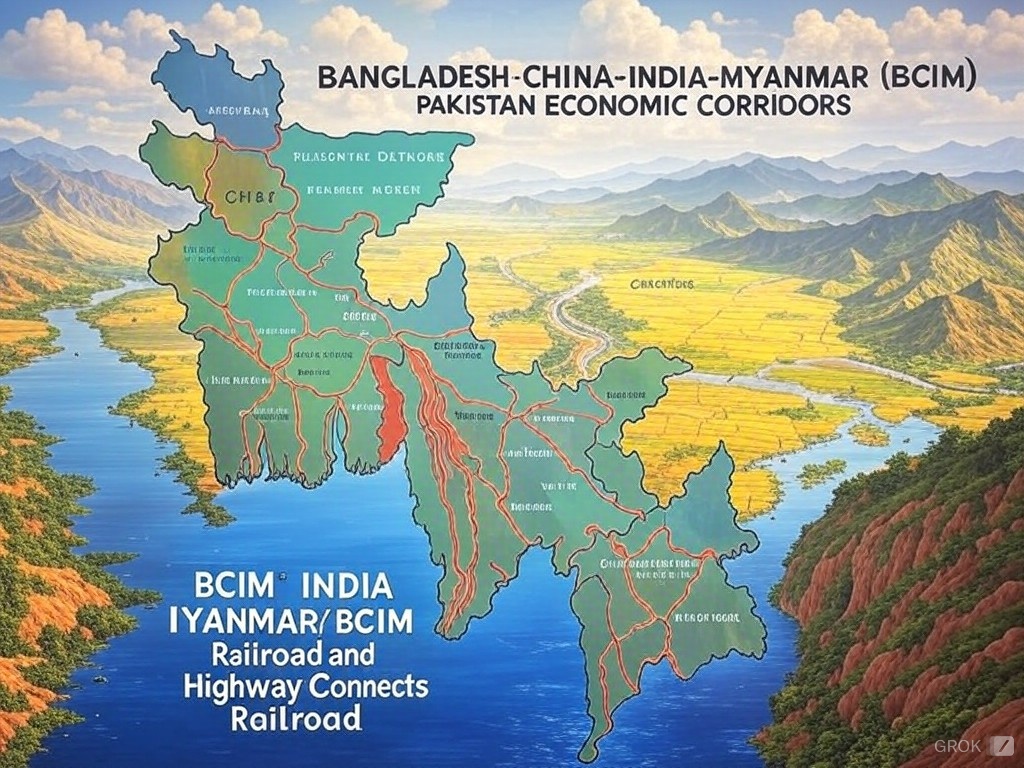Hello!
Introduction
The Bangladesh-China-India-Myanmar (BCIM) Economic Corridor and the China-Pakistan Economic Corridor (CPEC) are ambitious projects aimed at enhancing connectivity, trade, and economic cooperation across Asia. These corridors, part of China's Belt and Road Initiative (BRI), promise to reshape the economic landscape of the region by fostering development, reducing poverty, and boosting regional integration.
 Enhanced Collaboration: The Quasa Connect service could play a pivotal role in enhancing interaction among businesses, governments, and communities within the BCIM and CPEC corridors. By providing a platform for transparent, traceable, and optimized communication, Quasa Connect can facilitate the exchange of information, ideas, and resources.
Enhanced Collaboration: The Quasa Connect service could play a pivotal role in enhancing interaction among businesses, governments, and communities within the BCIM and CPEC corridors. By providing a platform for transparent, traceable, and optimized communication, Quasa Connect can facilitate the exchange of information, ideas, and resources.
This service leverages blockchain technology to ensure secure and reliable interactions, which is crucial in such expansive and diverse economic corridors where trust and efficiency in communication can accelerate project timelines and economic outcomes.
Whether it's coordinating logistics, sharing technological innovations, or managing cross-border payments, Quasa Connect could become an indispensable tool in knitting together the economic fabric of these regions.
The BCIM Economic Corridor
 Economic Growth and Connectivity:
Economic Growth and Connectivity:
- Market Access: The BCIM corridor connects some of the world's most populous and economically vibrant regions, providing access to vast markets and diverse resources. It envisions a multi-modal transport network including road, rail, water, and air linkages, which could significantly reduce transaction costs and stimulate trade.
- Infrastructure Development: One of the core objectives is to improve infrastructure, which includes ports, highways, and energy projects. This could lead to industrial zones, particularly in underdeveloped areas, promoting economic activity and employment.
- Poverty Alleviation: By integrating economies and improving connectivity, the corridor aims to lift millions out of poverty through enhanced trade opportunities and job creation. This is especially crucial in the northeastern regions of India, which could benefit from increased economic activity.
 Challenges and Opportunities:
Challenges and Opportunities:
- Geopolitical Tensions: The corridor's progress has been stymied by geopolitical issues, notably between India and China. India's reluctance to fully engage with the BRI due to sovereignty concerns regarding the CPEC has influenced the status of BCIM. However, the project's potential to foster mutual benefits might encourage a diplomatic resolution.
- Cultural and Economic Exchange: Beyond economics, BCIM could serve as a platform for cultural exchange and cooperation in education, sports, and science, promoting regional harmony.
The China-Pakistan Economic Corridor (CPEC)
 Strategic and Economic Importance:
Strategic and Economic Importance:
- Geographical Advantage: CPEC offers China a direct route to the Arabian Sea via Gwadar Port, reducing dependence on the Strait of Malacca for energy imports. This corridor is seen as a strategic move to counterbalance the geopolitical dynamics in South Asia.
- Economic Development: For Pakistan, CPEC promises not only infrastructure development but also energy projects that could address chronic energy shortages. Investment in roads, railways, and industrial zones could transform Pakistan's economic landscape, potentially making it a hub for regional trade.
- Regional Integration: CPEC is not just a bilateral project but has broader implications for regional stability and economic integration, linking Central Asia with South Asia.
Challenges and Prospects:
- Security Concerns: The corridor passes through regions with security issues, necessitating a robust security framework to protect investments and ensure project completion.
- Debt Sustainability: There are concerns about Pakistan's ability to manage the debt from Chinese loans, which could lead to economic dependency if not managed well.
- Sovereignty and Politics: The route through disputed territories like Gilgit-Baltistan has been a point of contention, with India objecting to its path through what it considers occupied territory.
Conclusion
The BCIM and CPEC corridors represent monumental efforts in international cooperation aimed at economic upliftment and regional integration. Despite the hurdles of geopolitical tensions, infrastructure challenges, and financial sustainability issues, the potential benefits in terms of economic growth, job creation, and connectivity are significant.
If managed with transparency and mutual respect for sovereignty, these corridors could serve as models for how regional cooperation can lead to collective prosperity. The true potential of these projects lies not just in the infrastructure they promise but in the broader socio-economic transformation they can catalyze across Asia.
Thank you!
Join us on social media!
See you!






